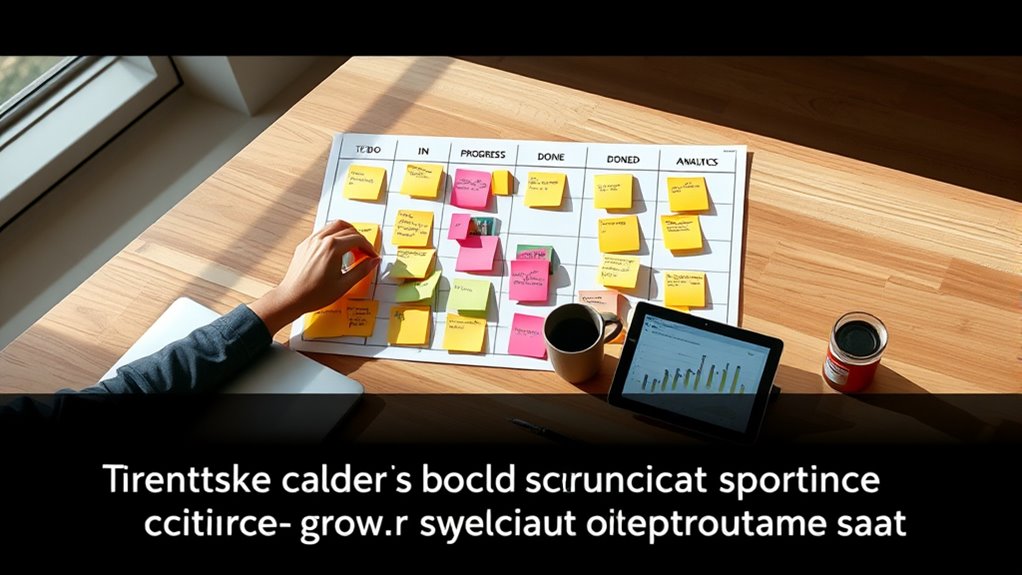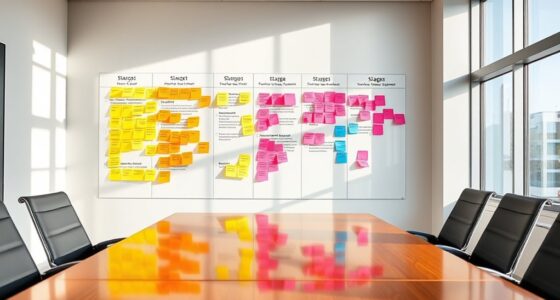To master backlog grooming, you should set clear goals for each session, prepare and organize your backlog ahead of time, and involve key stakeholders to gather valuable input. Prioritize high-impact items using effective methods like MoSCoW, break down large tasks into manageable pieces, and use consistent estimation techniques. Keep your backlog clean and up-to-date, limit session durations to stay focused, and document decisions to guarantee alignment. If you want to optimize your approach, there’s more to explore.
Key Takeaways
- Define clear objectives for each grooming session to stay focused on refining, estimating, and prioritizing backlog items.
- Regularly review and update backlog items for clarity, relevance, and accurate prioritization based on business value.
- Involve stakeholders early and often to align priorities and incorporate diverse feedback.
- Use prioritization frameworks like MoSCoW and effort-impact matrices to categorize and sequence tasks effectively.
- Keep sessions time-boxed with a clear agenda, facilitator, and break down large tasks into manageable chunks for efficiency.
Set Clear Objectives for Each Session

Setting clear objectives for each backlog grooming session is essential to keep the team focused and guarantee productive meetings. When your goals are well-defined, team motivation stays high, as everyone understands what needs to be achieved. Clear objectives also improve stakeholder communication by setting expectations upfront, ensuring everyone is aligned on priorities and outcomes. By establishing specific targets—such as refining user stories, estimating effort, or reordering backlog items—you create a structured approach that minimizes confusion and wasted time. This structured planning helps your team stay engaged and motivated, knowing exactly what they’re working toward. Additionally, understanding space and organization techniques can inspire creative ways to break down complex tasks into manageable pieces. Ultimately, setting objectives streamlines the grooming process, making each session more efficient and valuable for the project’s success.
Prepare the Backlog in Advance

Preparing the backlog before each grooming session guarantees that you can focus on meaningful discussions rather than sorting through unorganized items. To do this effectively:
- Review and update tasks using backlog grooming tools to make certain everything is current.
- Apply prioritization strategies to identify high-value items that need attention first.
- Clarify descriptions and add relevant details for smoother decision-making.
- Remove outdated or irrelevant items to keep the backlog lean and focused.
- Incorporate content organization techniques to streamline the grooming process and enhance team productivity.
- Consider potential cybersecurity vulnerabilities that could impact task prioritization or data security during backlog management.
- Stay informed about market trends and insights to better understand how external factors might influence backlog prioritization and project planning.
- Regularly monitoring product shelf life and storage conditions can help prevent issues that might cause rework or delays in project tasks. Additionally, understanding the latest security practices can help safeguard sensitive project data during backlog handling.
Involve the Right Stakeholders

Involving the right stakeholders guarantees that your backlog reflects the most valuable and feasible work. When you engage those who understand both the project goals and technical constraints, stakeholder communication becomes more effective. Their feedback integration ensures that priorities stay aligned with business needs and user expectations. By including product owners, developers, and end-users in grooming sessions, you gain diverse insights and foster commitment. Incorporating cultural intelligence can also enhance communication clarity and engagement during discussions. Additionally, understanding water-based activities can help tailor solutions that meet user preferences and promote active participation. Recognizing self watering plant pots features can further assist in developing practical solutions that align with user needs and environmental considerations. Being aware of cookie categories and their purposes can help ensure that your team respects user privacy and consent preferences during backlog refinement.
Prioritize Items Effectively

To prioritize backlog items successfully, you need clear criteria that guide your decisions and keep everyone aligned. Using methods like MoSCoW helps you categorize tasks effectively, ensuring the most critical work gets attention first. Remember to reassess priorities regularly so your backlog stays relevant as project needs evolve. Incorporating candy innovations can inspire creative approaches to problem-solving within your team. Additionally, understanding the brewing methods can help you evaluate tasks related to process improvements and optimize workflows accordingly. Exploring remote hackathons can also provide fresh perspectives and collaborative strategies for tackling backlog challenges more dynamically. Emphasizing market trends can help you align your backlog with evolving reader interests and industry shifts. Incorporating educational toys insights can also help you identify value-driven tasks that support development goals effectively.
Clear Prioritization Criteria
Establishing clear prioritization criteria is essential for effective backlog grooming, as it guides you in deciding which items to focus on first. To do this efficiently, use a priority matrix that balances factors like impact and effort. Guarantee stakeholder alignment by involving key players early, so everyone agrees on what matters most. Here’s how to set your criteria: 1. Assess business value and customer impact. 2. Consider technical complexity and risk. 3. Evaluate urgency and deadlines. 4. Align with strategic goals and stakeholder input. Incorporating insights from project planning can further enhance your prioritization process. Additionally, understanding gear shifting techniques can help in managing tasks smoothly as priorities change. Recognizing the importance of leadership skills in guiding teams through shifting priorities ensures that progress remains focused and adaptable.
Use of MoSCoW Method
The MoSCoW method offers a straightforward way to prioritize backlog items by categorizing them into four groups: Must have, Should have, Could have, and Won’t have. This simple prioritization framework helps you focus on what truly matters, aligning with stakeholder engagement and project goals. Use it to clarify priorities during grooming sessions, ensuring everyone understands the importance of each item. The table below illustrates how you might organize your backlog:
| Must Have | Should Have |
|---|---|
| Critical features | Important but non-essential |
| Legal requirements | Enhancements for user experience |
| Security updates | Nice-to-have improvements |
| Core functionalities | Optional features |
| Regulatory compliance | Future considerations |
Applying MoSCoW streamlines decision-making, making prioritization transparent and collaborative.
Regular Reassessment Cycles
Regular reassessment cycles are essential for keeping your backlog relevant and prioritized effectively. By regularly evaluating your items, you ensure that the highest priority tasks stay at the top. To optimize your cycle frequency, consider these key points:
- Decide on a consistent schedule, such as weekly or bi-weekly, for priority reassessment.
- Adjust cycle frequency based on project urgency or team capacity.
- During each cycle, re-evaluate item importance, dependencies, and deadlines.
- Remove or defer low-priority tasks to keep the backlog focused and manageable.
Implementing a disciplined cycle frequency helps you stay aligned with changing priorities and ensures your backlog remains a valuable tool for effective planning. Regular reassessment keeps your team focused and agile.
Break Down Large Tasks Into Manageable Chunks

When faced with a large task, breaking it into smaller, manageable chunks makes the work less overwhelming and easier to complete. This process, known as task decomposition, helps you identify specific components and distribute work more effectively. Start with a scope breakdown to define clear boundaries for each subtask, ensuring they are actionable and realistic. By dividing complex tasks, you gain better insight into the effort required and reduce the risk of overlooked details. This approach also facilitates progress tracking and prioritization. Focus on creating logical, bite-sized pieces that align with your project goals. Remember, smaller tasks are easier to estimate, assign, and complete, leading to a smoother backlog grooming process and more predictable delivery.
Use Estimation Techniques Consistently

To guarantee accurate planning, you need to use estimation techniques consistently across your backlog. Standardizing your methods, like adopting relative sizing, helps your team compare tasks more effectively. Keep your units uniform so everyone stays aligned and your estimates remain reliable.
Standardize Estimation Methods
Standardizing estimation methods guarantees your team produces consistent and reliable backlog forecasts. To achieve this, focus on the following:
- Choose a single story estimation technique, like planning poker or t-shirt sizes, to ensure effort consistency across the team.
- Document your chosen method so everyone understands and applies it uniformly.
- Train team members regularly to refine their story estimation skills and maintain accuracy.
- Review and calibrate estimates periodically to identify discrepancies and improve estimation precision.
Use Relative Sizing Techniques
Consistent use of relative sizing techniques guarantees your team estimates effort more accurately across different backlog items. By adopting relative sizing, you compare tasks against each other rather than assigning fixed hours, which reduces estimation bias. Use story points as your standard unit to measure effort, complexity, or risk consistently. This approach helps your team develop a shared understanding of what each size represents, improving estimation reliability. When team members consistently apply relative sizing, your backlog grooming sessions become more efficient, and estimates become more predictable. Avoid switching estimation techniques mid-project, as this can create confusion and inconsistency. Ultimately, sticking with relative sizing and story points helps your team better plan sprints, allocate resources, and deliver value more effectively.
Maintain Consistent Units
Maintaining consistent units across your backlog guarantees that your team’s estimates remain reliable and comparable over time. To achieve this, focus on these key practices:
- Use the same estimation technique, such as story points or hours, for all stories to ensure consistency in story prioritization.
- Regularly review your units with stakeholders to align expectations and maintain stakeholder engagement.
- Document your chosen units and rationale, helping new team members adapt quickly.
- Avoid switching units mid-project, as this can skew velocity and mislead prioritization efforts.
Keep the Backlog Organized and Up-to-Date

To keep your backlog organized and up-to-date, you need to regularly review and refine it. Use prioritization strategies to ensure the most critical items are addressed first, helping your team focus on high-value tasks. Keep your backlog visualization clear by categorizing and grouping related items, making it easier to identify dependencies and progress. Regular grooming sessions help you eliminate outdated or low-priority tasks, preventing clutter. Updating task details, estimates, and statuses keeps everyone on the same page. Consistent organization guarantees that your backlog accurately reflects current project priorities, enabling smoother planning and execution. By maintaining a well-structured backlog, you reduce confusion and improve your team’s efficiency, ultimately delivering value faster and more reliably.
Limit Session Duration and Maintain Focus

When managing backlog grooming sessions, keeping the team focused and on schedule is key to staying productive. To improve time management and session facilitation, set a strict time limit for each meeting. Consider these tips:
Set strict time limits for backlog grooming to stay focused and boost productivity.
- Define a clear agenda and stick to it.
- Use a timer to signal when time is almost up.
- Prioritize high-impact items to avoid scope creep.
- Assign a facilitator to keep discussions on track and prevent digressions.
Limiting session duration helps prevent fatigue and maintains engagement. Staying focused ensures you cover essential backlog items efficiently. Good session facilitation keeps everyone aligned and prevents unnecessary delays. Remember, concise meetings lead to more effective backlog grooming and better project outcomes.
Document Decisions and Action Items

Clear documentation of decisions and action items is essential for keeping your backlog grooming sessions productive and ensuring accountability. As you discuss prioritization trade-offs, record the rationale behind each choice, including how stakeholder feedback influenced the outcome. Tracking stakeholder feedback helps clarify why certain items are prioritized over others, preventing miscommunication later. Document specific action items, assign responsible team members, and set clear deadlines to maintain momentum. This organized record serves as a reference for future sessions and helps track progress. Well-maintained documentation guarantees everyone stays aligned on decisions, minimizes misunderstandings, and makes it easier to revisit and adjust priorities as new information emerges. Effective documentation ultimately streamlines your backlog management and supports smoother project execution.
Frequently Asked Questions
How Often Should Backlog Grooming Sessions Be Held?
You should hold backlog grooming sessions weekly or bi-weekly, depending on your project’s pace. During these sessions, use prioritization techniques like MoSCoW or Kano to keep the backlog focused. Engage stakeholders actively to gather feedback and make sure their priorities are reflected. Regular sessions help you stay aligned with project goals, prevent backlog clutter, and keep everyone informed, making the development process smoother and more efficient.
What Tools Are Recommended for Backlog Organization?
You should use visual management tools like Jira, Trello, or Azure DevOps to organize your backlog effectively. These tools help you implement prioritization strategies by allowing you to easily sort, categorize, and update tasks. They also enable you to see the bigger picture at a glance, making it easier to identify high-priority items and manage your backlog efficiently. Consistently updating these tools guarantees smooth backlog grooming sessions and better project flow.
Who Should Always Be Involved in Grooming Sessions?
Think of backlog grooming sessions like a well-orchestrated symphony—you need the right players to hit every note. You should always involve the product owner, development team members, and key stakeholders. Your goal is to foster team collaboration and stakeholder engagement, ensuring everyone’s voice shapes the priorities. By including these core participants, you keep the backlog refined, clear, and aligned with project goals, making your process more efficient and effective.
How Do You Handle Conflicting Stakeholder Priorities?
When conflicting stakeholder priorities arise, you should use prioritization strategies like scoring or MoSCoW to balance needs effectively. Communicate openly with stakeholders to understand their perspectives, then facilitate discussions to align on shared goals. Keep everyone informed about how decisions are made, ensuring transparency. By actively managing expectations and applying clear prioritization strategies, you help the team focus on high-value work, reducing conflicts and improving overall backlog clarity.
What Are Common Pitfalls to Avoid During Backlog Grooming?
Imagine you’re organizing a cluttered closet; missing details can cause chaos. During backlog grooming, avoid prioritization mistakes and unclear user stories that stall progress. Don’t rush through stories or ignore stakeholder input—this leads to confusion and missed deadlines. Instead, clarify stories, prioritize effectively, and keep communication open. This approach guarantees your backlog remains manageable, making your sprint planning smoother and your team more confident.
Conclusion
Think of backlog grooming as tending a garden—you nurture each plant, prune the overgrowth, and organize your space. By setting clear goals, involving the right people, and keeping everything tidy, you cultivate a healthy, thriving project. When you approach each session with focus and care, you ensure your backlog blossoms with valuable tasks. Remember, your consistent effort is the sunlight that helps your project grow strong and fruitful, season after season.









